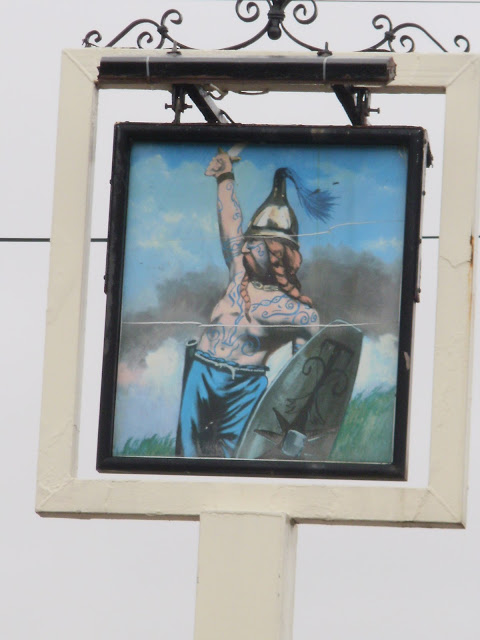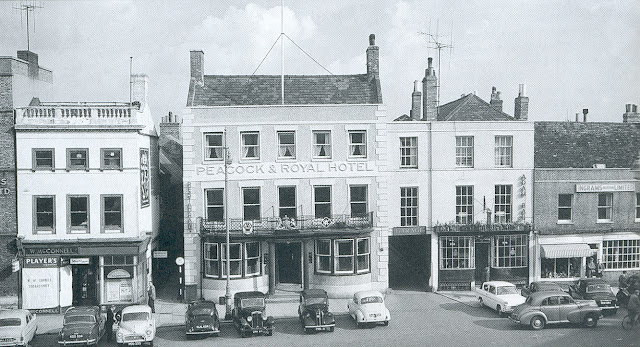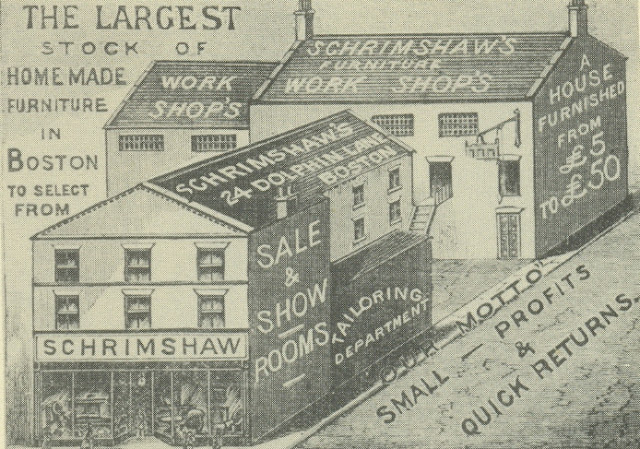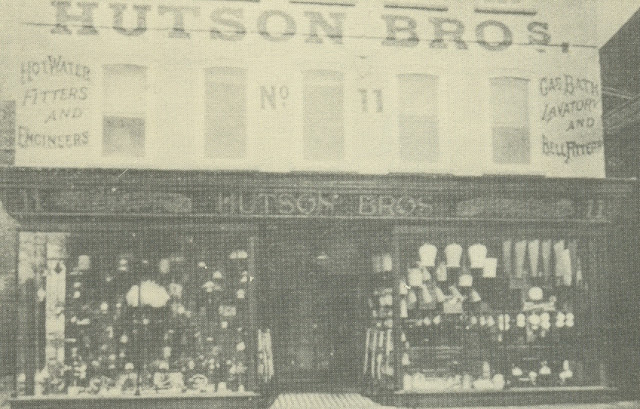AARDVARK.
also known as the Ram.
In its last days as a public house the Ram (above) down Wide Bargate was renamed the Aardvark for a while.
ALMA.
The building above, number 7 South End, and now a private house called Quay side, was once a pub called the Alma.
ANCHOR.
ANGEL.
The Angel Inn, Market Place.
ANGEL AND FOXE.
also known as the Bell, Rum puncheon, Marthas vineyard and Stump and Candle.
Named Angel for its closeness to the old Angel pub and Foxe because John Foxe the Martyrologist was born in a house on the site.
AXE AND CLEAVER.
also known as Stumps and Gigolo's
Two views of the Axe and Cleaver in West street.
BAR 1874.
also known as the Haven and the New Park Inn.
Bar 1874.
BARGE.
also known as Ward's Hotel.
The Barge on Tattershall Road, now converted into flats.
BELL. in the market place.
also known as the Rum Puncheon, Marthyrs vineyard, Angel and Foxe and Stump and Candle.
John Foxe the Martyrologist was born on this site in the Market Place.
BELL. in Wide Bargate.
Pishey Thompson 1856.
BLACK BEAR.
BLACK BULL.
BLACK HORSE.
BLUE LION.
The Blue Lion pub near the present day site of the footbridge across the Haven.
BOAT
This building in High Street was once a public house called the Boat.
BOROUGH ARMS.
BOSTON BLITZ.
also known as the Falcon.
The Falcon (New Street) was an old Boston pub and the Boston Blitz (American football themed) was an unsuccessful attempt to modernise it. The site is now an Argos store.
Pishey Thompson 1856.
BOSTON STILL
also known as the Still.
BREWERS ARMS. Norfolk Place.
BRITANNIA.
BULL. in London Road.
Pishey Thompson 1856.
BULL AND MAGPIE.
CARPENTERS ARMS.
CASE IS ALTERED. Tattershall Road.
CASTLE.
also known as the New Castle.
Top: The Castle. Above: in the bar.
CASTLE TAVERN.
CLARENCE.
COACH AND HORSES.
CORN EXCHANGE HOTEL.
Above: The Corn Exchange.
Below: Where it was situated.
CROOKED BILLET.
also known as the Joiners Arms.
The site of the Crooked Billet.
Pishey Thompson 1856.
CROSS KEYS.
also known as the New England.
CROWN.
Pishey Thompson 1856.
The narrow alley to the left of "Savers" that used to lead to the Crown.
CROWN AND ANCHOR.
Above: The large grey building in the centre was the Crown and Anchor up to the late 19th. century when the license was moved to smaller premises six doors to the left.
Below: The smaller premises (now demolished) and the plaque that remains.
DOG AND DUCK.
also known as the Wormgate and Goodbarns Yard.
Pishey Thompson 1856.
DOLPHIN.
(DUKE OF) WELLINGTON.
DUKE OF YORK.
DUKES HEAD. Duke Street.
EAGLE.
ELEPHANT AND CASTLE.
also known as the Five Lamps.
FALCON.
also known as Boston Blitz.
Pishey Thompson 1856.
FIVE LAMPS.
also known as the Elephant and Castle.
FLYING DUTCHMAN.
Rosegarth Street.
The tall building is the Flying Dutchman in Rosegarth St.
GEORGE AND DRAGON.
GIGOLO'S.
also known as the Axe and Cleaver and Stumps.
GOLDEN FLEECE.
GOLDEN LION.
GOODBARNS YARD.
also known as The Wormgate and the Dog and Duck.
GOOD WOMAN.
GREAT NORTHERN.
GREEN DRAGON.
Pishey Thompson 1856.
The Athenaeum, built on the site of the Green Dragon. After becoming part of the New Theatre it was demolished and the site now covered by Marks and Spencers.
GREYHOUND.
HAVEN.
also known as the New Park Inn and Bar 1874.
HESSLE HOUSE.
also known as the Hessle Pear.
HESSLE PEAR.
also known as the Hessle House.
The site of the Hessle Pear with just the sign remaining.
HOP POLE.
HOPE AND ANCHOR.
also known as the Crown and Anchor.
INDIAN QUEEN.
also known as the Three Kings of Cologne.
Pishey Thompson 1856.
JOINERS ARMS.
also known as the Crooked Billet.
Pishey Thompson 1856.
JOLLY CRISPIN.
The name painted in large letters on the side wall of the pub.
KING WILLIAM IV.
KINGS ARMS.
KINGS HEAD.
KITWOODS.
LITTLE PEACOCK.
Pishey Thompson 1856.
LITTLE PEACOCK TAP.
LOCOMOTIVE.
LONDON TAVERN.
This building (next to Shodfriars Hall)was once the London Tavern.
LORD NELSON. in High St.
Above:The Lord Nelson, on the left, next to the Royal Oak.
Below: Two statuettes that stood on the frontage of the Lord Nelson.
LORD NELSON. in Woodville Rd.
MAGNET.
MARINERS HOME.
MARTHA'S VINEYARD.
also known as the Angel and Foxe, Bell, Rum Puncheon and Stump and Candle.
MASONS ARMS.
MILL.

MITRE.
MOON UNDER WATER.
also known as the Schnapps Bar.
NAGS HEAD.
NAPOLEON.
NEPTUNE.
NEW CASTLE.
also known as the Castle.
NEW ENGLAND.
also known as the Cross Keys.
NEW INN.
NEW PARK INN.
also known as the Haven and Bar 1874.
NORTH POLE.
The North Pole (the white curved building) stood on Mill Hill.
OLD DOVER.
OLD WHITE HART.
Pishey Thompson 1856.
OSTRICH.
PACKET HOUSE.
PACKHORSE.
PATENT STILL.
PEACOCK AND ROYAL.
also known as the Peacock.
PEACOCK.
also known as the Peacock and Royal.
PEACOCK TAP.
PJ's Pie pub.
also known as the Robin Hood.
The Robin Hood became PJ's Pie pub for a while but has now (2012) reverted to its old name of Robin Hood.
PLOUGH.
PRINCE ALBERT.
PRINCE OF WALES.
PROSPECTS.
also known as the Waterfront.
QUEEN OF SPADES.
QUEENS HEAD.
RAILWAY.
RAM.
also known as the Aardvaark.
RED COW.
RED LION.
ROBIN HOOD.
also known as PJ's Pie pub.
RODNEY AND HOOD.
ROPERS ARMS.
ROSE AND CROWN.
ROYAL GEORGE.
This building (now a restaurant) was once the Royal George.
ROYAL OAK.
RUM PUNCHEON.
also known as theBell, Angel & Foxe, Marthas and the Stump & Candle.
SAILORS RETURN.
SARACENS HEAD.
Pishey Thompson 1856.
SCHNAPPS BAR
also known as the Moon under Water.
SEVEN STARS.
SHADES.
SHAKESPEARE.
SHIP. in London Road.
SHIPS ARMS.
SHIP TAVERN.
SHIPWRIGHTS ARMS.
SHUNTERS.
SPATZ.
also known as theRoyal George.
SPIRIT OF ENDEAVOUR.
STAG AND PHEASANT.
STAR AND GARTER.
STATION HOTEL.
STEAM PACKET.
STILL.
also known as the Boston Still.
STUMP AND CANDLE.
also known as the Rum Puncheon, the Bell, Angel and Foxe and Marthas vineyard.
STUMPS.
also known as the Axe and Cleaver and Gigolo's.
SWORD.
Pishey Thompson 1856.
THREE CROWNS.
THREE KINGS OF COLOGNE.
also known as the Indian Queen.
THREE LOGGERHEADS.
THREE TUNS.
TOWN PUMP.
TURKS HEAD.
UNICORN.
VICTORIA.
VINE.
VOLUNTEER.
WAGGON AND HORSES.
WARDS HOTEL.
also known as the Barge.
WATERFRONT.
WHALE.
One of the back rooms of the Whale that had a mosaic of a Whale on the walls.
WHITE HART.
WHITE HORSE. (WHITE HORSE LANE)
WHITE HORSE (WEST STREET)
The statue of a white horse that was on the frontage of the White Horse pub in West Street.
WHITE SWAN.
WITHAM TAVERN.
WOAD MAN.
WOOLPACK.
Number 11, Wide Bargate was once a pub called the Woolpack.
WORMGATE.
also known as Goodbarns Yard and the Dog and Duck.
Slater's Directory 1852.
Pigot's Directory 1828/29.






















































































































































































